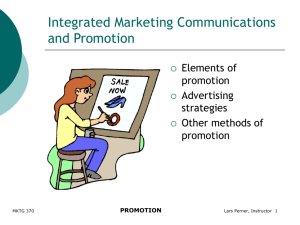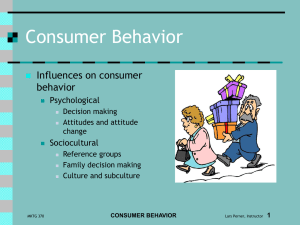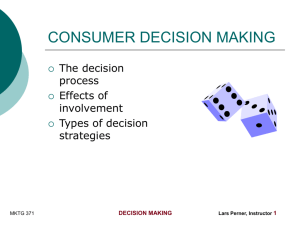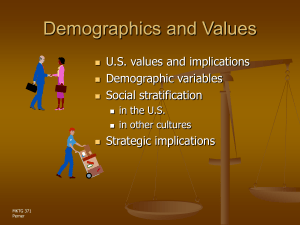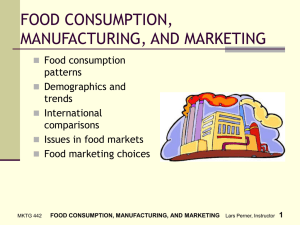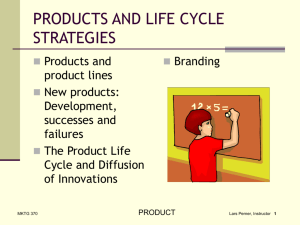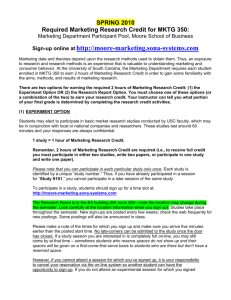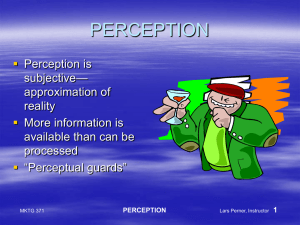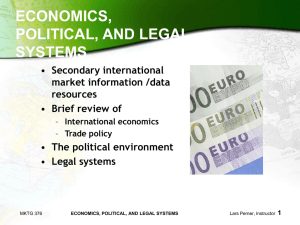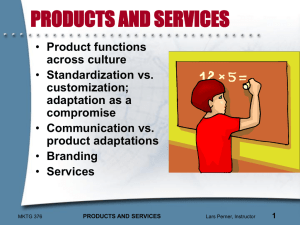Decision Making for Market Selection
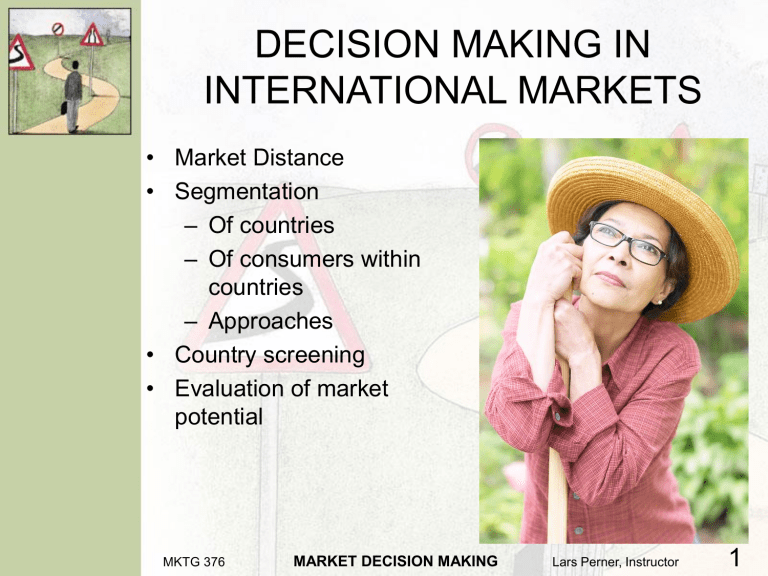
DECISION MAKING IN
INTERNATIONAL MARKETS
• Market Distance
• Segmentation
– Of countries
– Of consumers within countries
– Approaches
• Country screening
• Evaluation of market potential
MKTG 376 MARKET DECISION MAKING Lars Perner, Instructor
1
DOMESTIC
FIRM
Market Distances
GEOGRAPHICAL
DISTANCE
ECONOMIC
DISTANCE
POLITICAL
DISTANCE
TARGET
MARKET
PSYCHIC
DISTANCE
MKTG 376 MARKET DECISION MAKING Lars Perner, Instructor
2
Identifying International Markets
• Reactive approach
– Accidental entry through foreign orders not anticipated
– Economic pressure for sales increases
• Systematic approach
– Proactive
– Concentration of resources as needed
– Based on market scanning and research
MKTG 376 MARKET DECISION MAKING Lars Perner, Instructor
3
Country Segmentation
• Geographic
• Demographic
• Income
MKTG 376 MARKET DECISION MAKING Lars Perner, Instructor
4
Segmentation Within Countries
• Averages of countries are often not meaningful
• Implications of demographic factors will depend on country context —e.g., family income of $20,000 would be very affluent in India
– Will be able to pay for a lot of local service and manufacturing
– Able to hire others
• Example: Segmentation of Indian consumer families by income
– Rich (benefit maximizers--
$4840/yr)
– Consumers (costbenefit optimizers--
$1,030-4,839)
– Climbers (cashlimited benefit seekers--$495-1029)
– Aspirants ($360-494)
– Destitutes ($0-359)
MKTG 376 MARKET DECISION MAKING Lars Perner, Instructor
5
More Within-Country
Segmentation Examples
• China by age
– Generation I (45-59)
• Some received education
• Usually work or worked for State firms
– Generation II (30-44)
• Limited education opportunities
• Married, 1 “little emperor”
– Generation III (18-29)
• Better education
• Prospects for better, market economy
• Indian youth —psychographic
– Homebodies—traditional, low individuality
– Two-faced—”outwardly traditional; outwardly modern”
– Wannabes--“Materialistic mainstream;” “show-offs;” part of crowd
– Rebels—traditional parents; often first generation professionals; understood by friends, not parents
– Cool guys—”work hardplay hard;” confident, westernized
MKTG 376 MARKET DECISION MAKING Lars Perner, Instructor
6
Country Market Segmentation by
“Overall Market Attractiveness”
• “Platform” countries—for gathering intelligence and market info
• Emerging markets—current minimal markets but growing potential over time
• Growth markets—already experiencing high levels of growth
• Maturing markets—well entrenched competitors; often have sizable middle class
• Established markets—mature, usually fewer growth prospects; high competition but quite affluent
MKTG 376 MARKET DECISION MAKING Lars Perner, Instructor
7
Selection of Foreign Markets
• Preliminary screening
– Market size
• Population
• Income
– Accessibility—barriers:
• Tariff
– Import
– Export
• Non-tariff
– Government participation
– Procedures
– Product requirements
MKTG 376 MARKET DECISION MAKING
– Profitability
• Cost of barriers
• Risks
– Exchange rate
– Political
– Legal
• Selection and targeting
– Trade analysis
– Analogy—estimation based on performing of
“leading” country (e.g., using China to estimate
Vietnamese potential)
Lars Perner, Instructor
8
International Market Analytical
Tools
• Boston Consulting Group (Growth-Share) Matrix
• Market Attractiveness/Company Strength
– Primary markets
– Secondary markets
– Tertiary markets
MKTG 376 MARKET DECISION MAKING Lars Perner, Instructor
9
The Japanese Keiretsu
• Collection of firms with informal cross-ownership of stock
Preference for buying within the keiretsu
• Benefits
– Assures demand for product
– Able to pool resources over the Product Life Cycle
(bank in center)
• May keep inefficient firms in business too long
MKTG 376 MARKET DECISION MAKING Lars Perner, Instructor
10
Example of a Keiretsu
CHEMICAL
STEEL
ELECTRO-
NICS
AGRI-
CULTURE
AUTO
BANK
HEAVY
MACHI-
NERY TRANS-
PORTA-
TION
REST-
AURANT
MKTG 376 MARKET DECISION MAKING
FOOD
PRO-
CESSING
Lars Perner, Instructor
11
Some Economic Concepts
• “Permanent” income—expected average over lifetime
– Retirement expectations
– Employment expectations
• Conspicuous consumption
MKTG 376 MARKET DECISION MAKING Lars Perner, Instructor
12
Approaches to International
Market Segmentation
• Countries as segments (Macro-level segmentation]--country aggregate characteristics are used to classify country--e.g.,
– demographics (age distribution, urbanization, ethnic composition)
– socioeconomic (level of development]
• Segments within countries :
– intra market segmentation (unique segmentation scheme for each country]
– inter market segmentation [some segments overlap between countries]
MKTG 376 MARKET DECISION MAKING Lars Perner, Instructor
13
INTRA MARKET VS. INTER MARKET
SEGMENTATION
INTRA MARKET
•No overlap between countries
COUNTRY 1 COUNTRY 2
INTER MARKET
•Some, but not all,segments overlap between the two countries
•Comparable segments may differ in size between countries
COUNTRY 1 COUNTRY 2
C
A
B
D
E
G
A
B
F
H C
D
MKTG 376 MARKET DECISION MAKING
A
B
C
H
MKT 440
Lars Perner, Instrucror
Lars Perner, Instructor
Rev. 2/98
14
Intermarket vs. Intramarket
Differences, Part I
• (Compare to Analysis of Variance [ANOVA] in statistics)
• Average differences between countries but also significant differences within countries
• Segment structure may be similar, but segment sizes are likely to differ
• Relative vs. absolute differences--what is
“upscale” in a given country?
MKTG 376 MARKET DECISION MAKING Lars Perner, Instructor
15
Intermarket vs. Intramarket
Differences, Part II
• Global brands can serve similar consumers across borders --> possible economies of scale
• Product life cycle--segments in one country may follow or lead those of other country
MKTG 376 MARKET DECISION MAKING Lars Perner, Instructor
16
Positioning Across Markets:
Not an Easy Choice!
• Uniform or differential positioning across markets?
• Optimal position for product across countries may differ due to
– Country-of-origin effects
– Competitive and cost structure within country markets
• However, consistent image may be desirable due to
– spillover of advertising and promotional efforts (e.g., satellite TV, cross-country circulation of periodicals, portrayal in film/media )
– consumption by individuals who cross boundaries
MKTG 376 MARKET DECISION MAKING Lars Perner, Instructor
17
Marketing Mix Issues
• Need to address markets with
– Entrenched competitors
– High consumer expectations
– Discretionary income for new products
• Marketing mix decisions
– Product
– Price
– Distribution
– Promotion
MKTG 376 MARKET DECISION MAKING Lars Perner, Instructor
18

